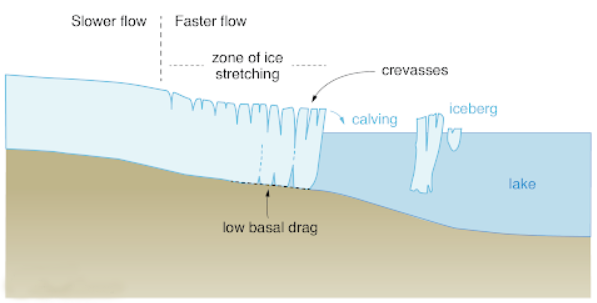-
Calving is the glaciological term for the mechanical loss (or simply, breaking off) of ice from a glacier margin.
-
Calving is most common when a glacier flows into water (i.e. lakes or the ocean) but can also occur on dry land, where it is known as dry calving.
Process:
-
Before calving occurs, smaller cracks and fractures in glacier ice grow into larger crevasses.
-
The growth of crevasses effectively divides the ice into blocks that subsequently fall from the snout into an adjacent lake (where they are known as icebergs).
-
Glacier Snout: It is the lowest end of a glacier, also called glacier terminus or toe.
Impact on Glacier Mass Balance:
-
In lake-terminating (or freshwater) glaciers, calving is often a very efficient process of ablation and is therefore an important control on glacier mass balance.
-
Ablation: It implies combined processes (such as sublimation, fusion or melting, evaporation) which remove snow or ice from the surface of a glacier or from a snow-field.
-
Glacier mass balance: It is simply the gain and loss of ice from the glacier system.
-
Global warming has increased the frequency of this process.
Recent Cases of Calving:
-
Up to the end of the 20th century, the Larsen Ice Shelf had been stable for more than 10,000 years.
-
In 1995, however, a huge chunk broke off, followed by another in 2002. This was followed by the breakup of the nearby Wilkins Ice Shelf in 2008 and 2009, and A68a in 2017.
Hydrofracturing
-
When water seeps into cracks at the surface, splitting the ice farther down – was almost certainly the main culprit in each case.
-
Hydrofracturing is a water well development process that involves injecting high pressure water via the well into the bedrock formation immediately surrounding it.
-
It was originally developed for the oil and gas industry to increase oil and gas well production.
-
On a global scale, drilling or hydrofracturing result in significant greenhouse gas emissions, leading to global warming.
